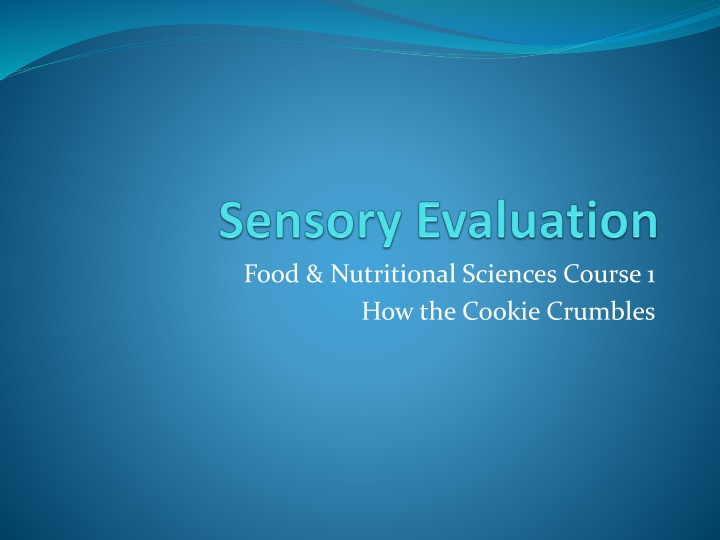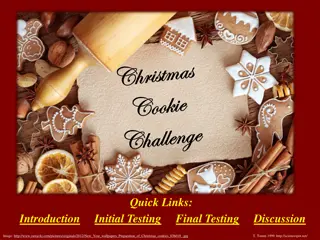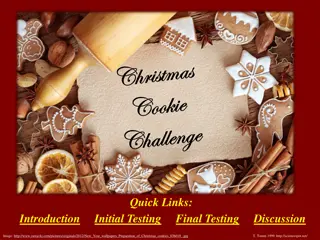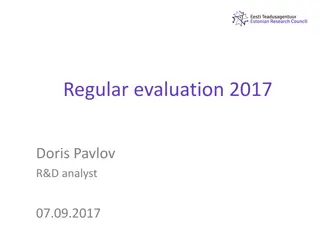The Science of Cookie Evaluation: A Detailed Guide
Delve into the world of food and nutritional sciences with a course focused on sensory evaluation instruments, hypothesis testing, data entry, and collection methods for analyzing the characteristics of cookies. Learn how to develop scales for sensory attributes, form hypotheses, collect and enter data accurately, and conduct taste tests with participants discreetly. Gain insights into the nuances of cookie evaluation and understand the importance of objective data analysis in food research.
Download Presentation

Please find below an Image/Link to download the presentation.
The content on the website is provided AS IS for your information and personal use only. It may not be sold, licensed, or shared on other websites without obtaining consent from the author.If you encounter any issues during the download, it is possible that the publisher has removed the file from their server.
You are allowed to download the files provided on this website for personal or commercial use, subject to the condition that they are used lawfully. All files are the property of their respective owners.
The content on the website is provided AS IS for your information and personal use only. It may not be sold, licensed, or shared on other websites without obtaining consent from the author.
E N D
Presentation Transcript
Food & Nutritional Sciences Course 1 How the Cookie Crumbles
Developing a Sensory Evaluation Instrument List all important characteristics Narrow list to 5 items Develop a scale for each characteristic from one extreme to another Example: Chewiness goes from too chewy to too crunchy Draw a 10cm line and place the extremes at either end of the line. Repeat for all characteristics
Hypothesis Before we can collect any data, we have to have a hypothesis to test for each item. Null hypothesis always states no difference Alternate hypothesis states difference Example for chewiness: Null: There is no difference in chewiness between the original recipe and the healthy recipe. Alternate: There is a difference in chewiness between the original recipe and the healthy recipe.
Hypothesis Note: we didn t state a direction of difference (chewier or crunchier) Write a hypothesis for each item. We ll explain testing after we have data.
Data Entry Measure the distance from the left side of the line to the participant s mark on each item and write in the margin (in centimeters). The number of centimeters with decimal values is the data. Enter into the cell for the participant and item #. Automatically calculates significance for you. If p < 0.05, there is a difference between the cookies.
Data Entry Enter all data in the spreadsheet: Item 1 Item 2 Item 3 Item 4 Item 5 Item 5 p1O 4.5 p1H 2.3 Difference Will Enter Formula Later p2O 6.8 p2H 5.0 Difference Will Enter Formula Later
Data Collection Decide on a labeling plan (and stick to it!) participant number Something to indicate healthy or original WITHOUT revealing to participant Present participant with on cookie on a plate & have taste Provide form & allow them to continue tasting while completing form
Data Collection Repeat with the other cookie You need 40 participants!
Data Analysis The spreadsheet has formulas ready to go You can type in the blue cells only.
Data Analysis If the p-value is less than 0.05, reject the null hypothesis There is a significant difference between the cookies If two-tailed t-score is greater than 0.05, keep the null hypothesis. There is not a significant difference between the cookies Repeat for all items and record your findings.
Drawing Conclusions Conclusions are the decisions you make based on your results. On which items did you have a significant difference between cookies? What do you think that means about people s cookie choices? Do you think your healthy option cookies will sell?























